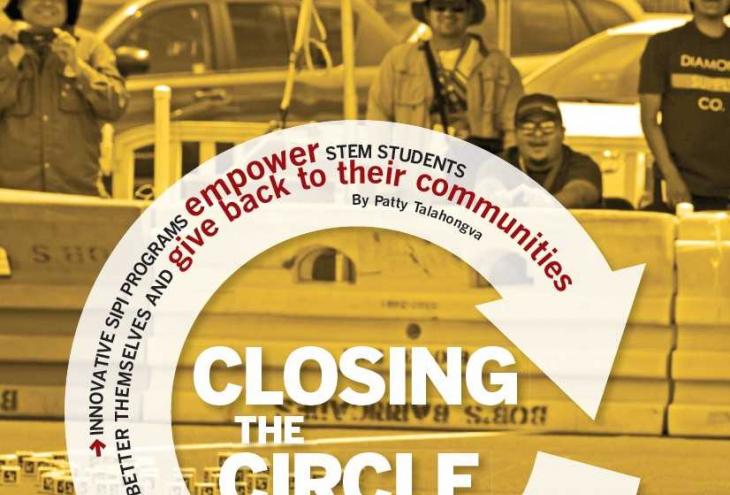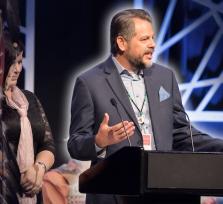Celebration was in the air at Southwestern Indian Polytechnic Institute (SIPI) this past April. A team of students from the Albuquerque, N.M., school had topped 20 other college teams to win the NASA Swarmathon. In this lively robotics competition, teams from minority-serving institutions develop computer code used by swarms of robots in an arena to autonomously find and collect the most resources. More than 500 students participated in this year’s event at the Kennedy Space Center in Florida.
The SIPI students eventually bested a team from the University of Houston to capture the grand prize for the physical competition, which included a $5,000 check for the school and the coveted Gold Mars Trophy. Members of the winning SIPI team were Glen Allen, Brian Bahe, Schulte Cooke, Mathew Gachupin, Geoff Gustina, Christian Martinez, Simonie Salazar, Ty Shurley, Joshua Sparvier, Emery Sutherland, Collin Whitehair, and Andrew Wright. Four students — Cooke, Martinez, Shurley, and Sutherland — repre - sented the group in Florida. Dr. Nader Vadiee, SIPI engineering professor, served as the team faculty advisor along with Jonathan West, adjunct instructor.
Creating Possibilities
For Vadiee, the recognition is a high point in a career spent largely in building SIPI’s engineering program. He started working with SIPI students in 1994 through a grant from Sandia National Labs. His work continued in 1998 through a NASA grant with the University of New Mexico, where he was a research associate professor. When that program ended in 2005, he helped write another grant to start an engineering program at SIPI. It was funded, and he transferred to SIPI.
“It takes a lot of time, passion, and love for your students,” he says. And he’s right. SIPI is an open-enrollment college, which means students don’t have to achieve a qualifying score on the ACT or SAT to enroll, and many arrive lacking proficiency in math and science. “It takes time to get them up to speed,” explains Vadiee.
When Vadiee recognized that some students needed extra help, he enlisted the aid of University of New Mexico students. “I worked with professors from UNM, and in exchange I asked them to send their graduate students as mentors,” says Vadiee. “I wanted them to work with our midlevel and struggling students.”
That approach has paid off. The average enrollment in SIPI’s engineering and engineering technology programs is about 60 full-time students. According to Vadiee, this is about 40 to 45 percent of all pre-engineering students enrolled in tribal colleges nationwide.
Still, he says there’s a long way to go because the playing field is not level. Despite the investment in the past 20 years, the graduation retention rate is low. “Seventy-five percent of our students can’t graduate in a timely manner,” he points out.
Building In Support
To help students stay in school and graduate, the original mentoring program has expanded, with freshmen mentored by sophomores and sophomores mentored by UNM students and professionals in industry. This collaboration among academic institutions and the business sector is all part of the VIP ROSE STEM program — Vertically Integrated Pyramid for Research, Outreach, and Student Education in Science, Technology, Engineering, and Mathematics. “In VIP you see the community, academia, and the industry working together,” says Vadiee. “That entire system is there to support the student academically. When students come to SIPI they join a support system.”
SIPI’s VIP ROSE STEM program may soon become a template. “I believe in sharing these resources with other tribal colleges,” says Vadiee. “Each one of us is strong in one aspect.” By replicating the program he is hopeful that the tribal colleges can share resources, aid in capacity building, and forge partnerships.
To that end, Vadiee will work with students and instructors from five tribal colleges this summer in the Tribal Colleges and Universities Advanced Manufacturing Technology Summer Institute, funded by the American Indian Higher Education Consortium. Attendees should expect to spend time with robots.
Outreach With Robots
In VIP ROSE STEM, robots are a wow factor that attracts and holds interest, so one of the projects this summer will be to build a rover mimicking the one on Mars. “We are going to build six, and participants will take them back to their colleges,” Vadiee says. Then those robots can be used as an outreach and education tool to recruit and engage more students.
A different kind of outreach can be accomplished by adding a natural language processing capability to the robots. At SIPI, students have worked with Inquiry Facilitators Inc. to create a code so a robot could understand simple commands in the Navajo language. “There are eight commands for the robot,” Vadiee explains, like “move forward” and “watch the wall.” The next step, he adds, “is for the rovers to process and converse in the Native natural language, like Siri on your phone or Amazon Alexa.”
When you teach a machine to understand and process a language, it’s called computational linguistics, and it’s an example of how STEM can bridge other fields, like language and culture. Vadiee is excited about what it could mean for preserving Native languages and helping students who are learning them.
Another big draw to his program is drones. “They are going to build a 3-D printable drone that can be used for remote sensing,” he says about his summer institute. “Some of the tribal colleges and communities already use drones for remote sensing, vegetation control, and natural resource management applications.”
Role of Education
Uses like drones and robots show the students the role of community and the role of engineering — and how their education can help their communities. Vadiee calls it “closing the circle.” In other words, you achieve reciprocity by creating a pipeline that starts from the community with the students and then goes back to the community after they earn their degrees. “These kids return to their communities — this is the goal. This is part of the charter of almost all the tribal colleges,” he says. “Their first contribution should be to their tribal communities. If students end up working for NASA that’s fine, but our first obligation is to the community.”
And SIPI students are eager to contribute. “I believe that tribes should have a feel for modern technology,” says Martinez, Laguna, who is majoring in network management. “I want to help people have a better understanding of what the world has to offer.”
Her teammate Cooke, Diné, is also looking at how he could give back. “My tribe is facing land issues right now, like big non-Navajoowned businesses moving onto the reservation to mine our resources,” he says. “Many people don’t understand the environmental issues this could cause.”
SIPI is providing an education that will enable students like Cooke to do just that, while preparing those who want to go on with a solid foundation. Since the inauguration of the VIP ROSE STEM program, Vadiee estimates 30 students have continued on to a four-year university. “And I can tell you at least four of my students have received their master’s degree or are in a graduate program,” he says proudly.
The reach of SIPI’s supportive programs and fields of study is broad. At SIPI pre-engineering is open to everyone on campus and works with all the sciences. “It’s a very collaborative program,” says Vadiee. “I have culinary arts students joining my program to learn how to grow food in space.” He also gets business students to do the market analysis for the robotics program, and communications students handle the Facebook page and the website. Alumni who are currently in four-year and graduate programs are hired as part-time research and teaching assistants to work as role models and mentors for freshman students with VIP ROSE STEM projects.
SPOTLIGHT ON Tribal Colleges
Vadiee is hoping that SIPI’s big Swarmathon win will not only boost the prospects for his students — present and future — but also have a positive effect on all tribal colleges, starting with raising their visibility. Last year his team won the Bronze Award, and SIPI was the only Native American college in the competition. The team set its sights on the Gold and now has bragging rights. The accolades rolled in immediately.
The Bureau of Indian Affairs sent out a news release quoting Secretary of the Interior Ryan Zinke: “Well done to the brilliant students at SIPI. These young people are breaking new ground and making everyone proud.” Bureau of Indian Education Director Tony Dearman’s statement read in part, “The post-secondary schools under the Bureau of Indian Education offer a great education. We at the BIE are enormously proud of the SIPI team for successfully tackling these challenges and showing the excellent education SIPI has to offer the students of Indian Country.”
Swarmathon champion Sutherland, Navajo, hopes that the reputation of all tribal colleges will get a boost. “Many tribal colleges are stereotyped as party schools,” he says, “so many graduates are not taken seriously. But SIPI’s first-place win will hopefully help change that attitude.”
The SIPI Swarmathon students now know what it feels like to compete in a group of 500 under intense pressure — and win. It’s that kind of experience that will motivate them to complete their degrees and find ways to help their communities. And that’s just what Vadiee envisions. “That’s my passion,” he says, “working with students. They are just like a diamond in the rough. My job is to clean the dust off and bring the shine out, but the shine is there already.”













